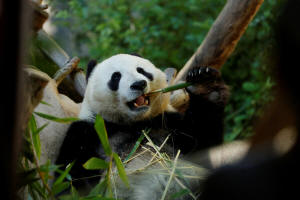For pandas, it's been two 'thumbs' up for millions of years
 Send a link to a friend
Send a link to a friend
 [July 01, 2022]
By Will Dunham [July 01, 2022]
By Will Dunham
WASHINGTON (Reuters) - Fossils unearthed in
China are helping scientists get a better grasp on one of the marvels of
evolution: the giant panda's false thumb, which helps this veggie-loving
bear munch the bamboo that makes up most of its diet.
Researchers said on Thursday they discovered near the city of Zhaotong
in northern Yunnan Province fossils about 6 million years old of an
extinct panda called Ailurarctos that bore the oldest-known evidence of
this improvised extra digit - actually a greatly enlarged wrist bone
called the radial sesamoid.
It closely resembled the false thumb of modern pandas, but is a bit
longer and lacks the inward hook present on the end in the extant
species that provides even greater ability to manipulate bamboo stalks,
shoots and roots while eating.

The false thumb is an evolutionary adaptation to augment the existing
five actual digits of the panda's hand. A bear's hand lacks the
opposable thumb possessed by humans and various primates that enables
the grasping and handling of objects using the fingers. The false thumb
serves a similar function.
"It uses the false thumb as a very crude opposable thumb to grasp
bamboos, sort of like our own thumbs except it is located at the wrist
and is much shorter than human thumbs," said Natural History Museum of
Los Angeles County paleontologist Xiaoming Wang, lead author of the
research published in the journal Scientific Reports.
Ailurarctos was an evolutionary forerunner of the modern panda, smaller
but with anatomical traits signaling a similar lifestyle including a
bamboo diet. The modern panda's false thumb has some advantages over the
earlier version.
"The hooked false thumb offers a tighter grasp of the bamboo and, at the
same time, its less-protruded tip - because of the bended hook - makes
it easier for the panda to walk. Think of the false thumb as being
stepped on every time the panda walks. And therefore, we think that is
the reason that the false thumb in modern pandas has become shorter, not
longer," Wang said.
The panda's tight grip on bamboo acts against the jerking action of the
mouth in order to quickly break food into bite-size chunks, Wang added.
[to top of second column]
|

Giant male panda Xiao Liwu eats a meal of bamboo before being
repatriated to China with his mother Bai Yun, bringing an end to a
23-year-long panda research program in San Diego, California, U.S.,
April 18, 2019. REUTERS/Mike Blake

The researchers initially found an Ailurarctos arm
bone in 2010, then discovered teeth and the false thumb in 2015,
giving them a much better understanding of the animal. Until now,
the oldest-known evidence of this thumb-like structure dated to
fossils from about 102,000-49,000 years ago in the same panda
species alive today.
The false thumb lets pandas hold bamboo to eat but not rotate the
food as a true thumb would allow.
"One of the most important features of human beings and their
primate relatives is the evolution of a thumb that can be held
against other fingers for precise grasping. The panda's false thumb
is far less effective than the human thumb, but it is enough to
provide the giant panda with the grasping ability to eat bamboo,"
said paleontologist and study co-author Tao Deng of the Chinese
Academy of Sciences in Beijing.
Pandas, one of the world's eight bear species, once inhabited large
swathes of Asia. They now live primarily in temperate forests in the
mountains of southwestern China, with a wild population estimated
under 2,000.
A panda's diet is 99% vegetarian, though they do sometimes eat small
animals and carrion. Because of their inefficient digestive system,
pandas consume large amounts to meet their nutritional needs - 26-84
pounds (12-38 kg) of bamboo while eating up to 14 hours a day.
The false thumb was not present in another closely related bear that
lived about 9 million years ago, the researchers said.

"This is a great innovation - transformation of a minor bone into an
element that is useful for a particular purpose," said Harvard
University paleobiologist and study co-author Lawrence Flynn.
(Reporting by Will Dunham, Editing by Rosalba O'Brien)
[© 2022 Thomson Reuters. All rights
reserved.]
This material may not be published,
broadcast, rewritten or redistributed.
Thompson Reuters is solely responsible for this content. |